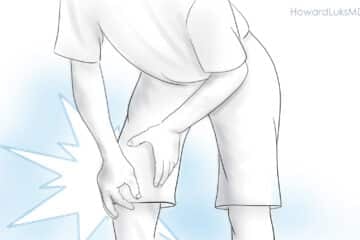
Are we defined by our laboratory and MRI findings….
We as physicians are commonly trained to treat disease, not patients. Another way of looking at it is that we are trained to think mechanically. If “X” is present, administer “y” and if “A” is broken, we must fix it. Orthopedic surgeons, in particular, are frequently trained to treat MRI findings and not necessarily how to incorporate patient values, or the tailor a treatment plan based on how a disease effects a patient’s quality of life. Many surgeons are not typically considering the patient’s underlying emotional status and the influence that this will have on the patient’s ultimate recovery. At-risk patients have significant anxiety and other psycho-social issues that affect their ability with regards to medical decision making and recovery from medical intervention.
Research has shown that *at risk* patients are agnostic with respect to socioeconomic background, age, or gender. The at-risk patient has significant anxiety, perhaps low-grade chronic depression and certainly diminished coping skills. In order to put in place or create an environment that ensures successful treatment of a disease state, it is imperative that the surgeon identify the at risk population preoperatively. This will enable us to put the proper mechanisms in place in order to insure a proper setting or environment for functional improvement in the postoperative setting. Identifying an at risk patient does not necessarily mean that the patient should not consider a proposed procedure – – – instead it should alert the physician that a multi-modal approach with the inclusion of social workers or psychiatrists and psychologists may be necessary.
Participatory Medicine, Patient Values and the Master Surgeon
I’ve always stated that great surgeons know how to perform most procedures well within their area of specialty. More importantly they know how to deal with complications as they arise and work towards the best situation possible to improve the likelihood of success. I’ve also been quoted as saying is that a master surgeon approaches patients as people, and not diseases. A master surgeon incorporates patient values, and can identify the at risk patient and institute measures to effectively manage and treat those patients both pre-and post-operatively and perhaps more importantly they can identify the at risk patient who should not be indicated for surgery.
For many patients it is impossible to separate the emotional and physical aspects of recovery from surgery or other disease states. There is frequently a mismatch between a patient’s subjective complaints versus the surgeon’s thoughts on objective impairment. It is the psychological issues and the coping skills of the patient that perhaps lead to this mismatch. Cognitive behavioral therapy and other non-conventional treatment modalities may prove to have a crucial role in aligning these issues.
What this boils down to is the art of patient – physician communication. It is incumbent upon the physician to have a clear sense of what the patient understands about their disease and to engage them further to improve their level of understanding. We can go further and provide the patient with information, booklets, or links to a website the patient can then review in the comfort of their own home or with other family members.
Those of you who frequent this blog understand that I am a strong believer in shared decision-making principles. I believe that a patient should clearly understand their diagnosis, the future implications of their disease, what the treatment alternatives are and what the risks of either nonoperative or operative treatment are and how the choice of surgical or nonsurgical management might affect them.
The *Personality* of an Injury (or disease state) …
I’ve spoken before about the low touch / high technology approach to orthopedics that is far too prevalent in our society. Not only does this lead to over testing and over treatment – it lends itself to ignoring the quality-of-life impact the disease/injury in question is having on the patient. When surgery is considered, this leaves many patients at risk for poor functional outcomes simply because the surgeon may not have recognized or addressed the non-physical functional needs of the patient. Orthopedic surgery cannot simply be defined as fixing a broken part, without the clear understanding of how our intervention affects a patient, and the fact that how a patient reacts to surgical or nonsurgical management, is simply not mechanical.
We need to treat our patients as people and not as disease states. We need to treat patients and not MRI findings. It is no longer advisable, nor perhaps acceptable, to look at a patient as possessing a mechanical issue and not consider the impact of whatever intervention we recommend on their lifestyle and quality of life.














What a great post. I think every doctor who reads this should forward a copy to every doctor he or she knows.
Love it! …
Thanks Julie!
Howard J Luks
Healthcare – Social Media – Orthopedic Surgery
Voted as one of Top Sports Doctors in United States :-)
I, as a chronic ortho patient (with ON in multiple joints) have been fortunate to find a group of orthos in Vail Co who are not the ” if all you have is a hammer everything is a nail” type of folks” each Dr I have worked there ( they mostly focus on one joint and have their own teams, but share a similar ethic and philosophy) and truly practices integrative/ participatory medicine. PT is the first protocol, and they have an integrated team there. They work with the patient, some call on Sundays and say hey call my cell and let me know how you are doing. Sadly I have to travel 1900 miles one way to get this treatment and I am not a famous athlete…just another person! It is a wonderful safety nest to have!
Howard, I would like to see/ read more of the things you would do/ an outline of how to address the non functional needs of the patient…what in your opinions should Drs do!
Great post. Thanks for sharing this with us.
I love what you said about pre operative and post operative
planning. It is important to have plans in place both before
and after surgery, and to provide the necessary resources for
patients who will need them.
Sincerely,
Keyon R. Mitchell, MSW
Thanks Keyon!
Treating the diagnoses and not the patient is unfortunately not limited to the medical field, however it is more prevalent there. Although in the mental health field the patient’s emotional and psychological state is considered, the values and wishes are sometimes neglected. Sometimes they are put on multiple medications to treat symptoms, but not explained how they can be addressed with therapy. Also often even with therapy there is a reluctance to explain the limits and how much therapy would be needed for a desired outcome. Also, although cognitive behavior therapy is effective, there are some people that it might be more helpful to integrate the effective strategies of cognitive behavioral therapy into another approach because the patient may not respond to cognitive behavioral therapy alone.
Very true Katrina… it is a complex subject, and I appreciate your meaningful input!
Howard Luks
Thanks for writing this. I’m a patient recovering from a tibial plateau fracture and torn meniscus, and have been recovering for 7 months; while I can walk with a limp, I can’t walk up and down stairs without a cane, and my insurance company has denied me further therapy citing I should be able to do this eventually at home myself. I have been desperately trying to get my doctor to appeal this decision in order to get an expedited response to have my therapy reinstated. To date, he hasn’t returned any of my phone calls and the office assistant sat on this request doing nothing for 2 weeks. I have been out of therapy for 5 weeks now and need to know how I can help myself progress because it’s unlikely that it will be restored before my next Dr.’s appt. .given these circumstances. After surgery, doctors must be accessible to their patients, because if they don’t fully recover, then the surgery has failed. We are not just a body part to be fixed, but human beings and the whole person has to be fixed.
Thank you for your comments Delores!